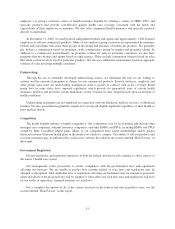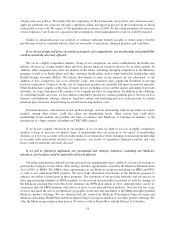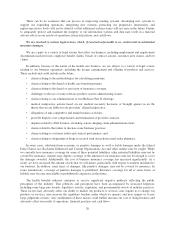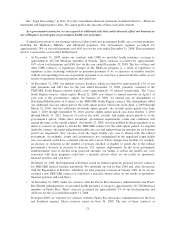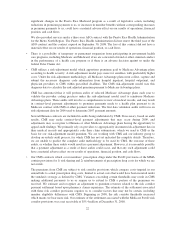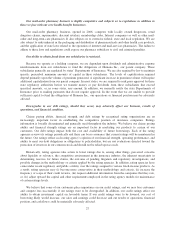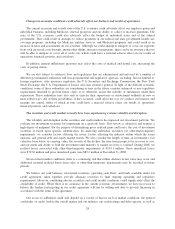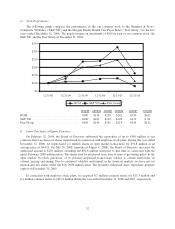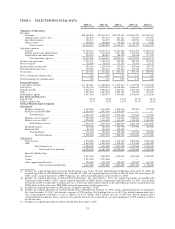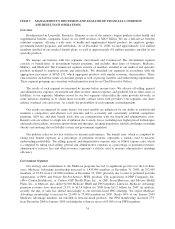Humana 2008 Annual Report Download - page 35
Download and view the complete annual report
Please find page 35 of the 2008 Humana annual report below. You can navigate through the pages in the report by either clicking on the pages listed below, or by using the keyword search tool below to find specific information within the annual report.• approval of entry, withdrawal or re-entry into a state or market;
• premium rates; and
• periodic examinations by state and federal agencies.
Two areas of legislation that can impact the company are experiencing continued activity. These are
Medicare funding under MMA and proposals to expand health insurance coverage. MMA funding and associated
program structure is an area of substantial legislative attention that may be influenced by federal budget
considerations and Medicare spending trends. The federal and state efforts to expand access to health coverage
may offer opportunities to serve individuals who are not currently in the health insurance market through public
program expansions, coverage connectors or premium assistance programs. Current state fiscal conditions may
affect the scope and scale of proposals. Some access proposals also include increased regulation of our
commercial business, particularly small group and individual, through a combination of benefit mandates,
underwriting restrictions, rating limitations and assessments.
State and federal governmental authorities are continually considering changes to laws and regulations
applicable to us and are currently considering regulations relating to:
• health insurance access and affordability;
• regulation of broker licensing and commission rates, particularly in the Medicare marketing area;
• e-connectivity and electronic health records;
• universal health coverage;
• disclosure of provider fee schedules and other data about payments to providers, sometimes called
transparency;
• disclosure of provider quality information; and
• formation of regional purchasing pools for small employers and individuals.
All of these proposals could apply to us and could result in new regulations that increase the cost of our
operations.
There can be no assurance that we will be able to continue to obtain or maintain required governmental
approvals or licenses or that legislative or regulatory change will not have a material adverse effect on us. Delays
in obtaining or failure to obtain or maintain required approvals could adversely affect entry into new markets, our
revenues or the number of our members, increase our costs or adversely affect our ability to bring new products
to market as forecasted.
We are also subject to potential changes in the political environment that can affect public policy and can
adversely affect the markets for our products.
While it is not possible to predict when and whether fundamental policy changes would occur, these could
include policy changes on the local, state, and federal level that could fundamentally change the dynamics of our
industry, such as a larger role of the government in the health care arena. Changes in public policy could
materially affect our profitability and cash flow, our ability to retain or grow our business, and our financial
position.
Any failure to manage administrative costs could hamper profitability.
The level of our administrative expenses impacts our profitability. While we proactively attempt to effectively
manage such expenses, increases in staff-related expenses, investment in new products, including our opportunities
in the Medicare programs, greater emphasis on small group and individual health insurance products, acquisitions,
and implementation of regulatory requirements, among others, may occur from time to time.
25


